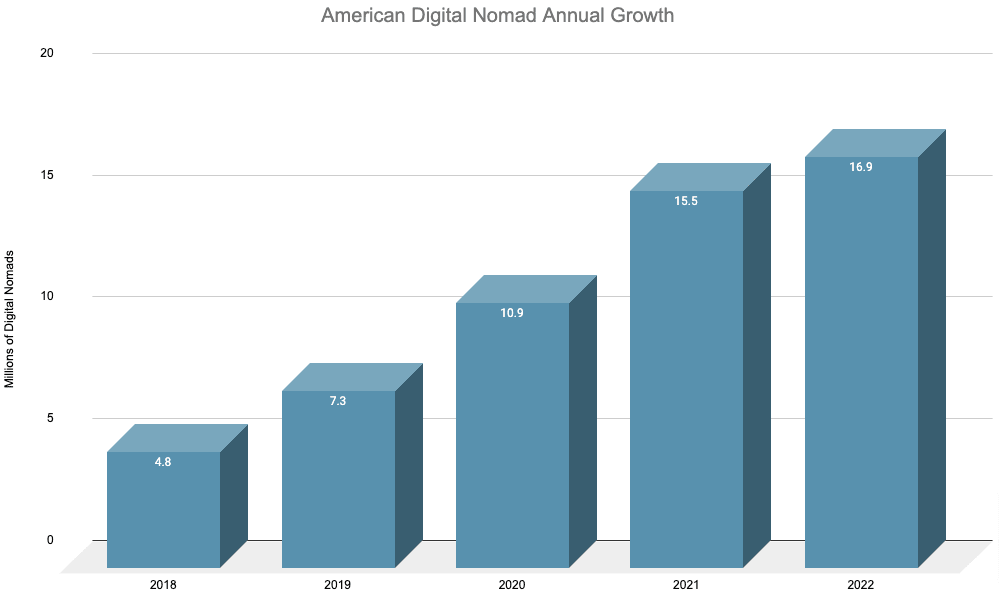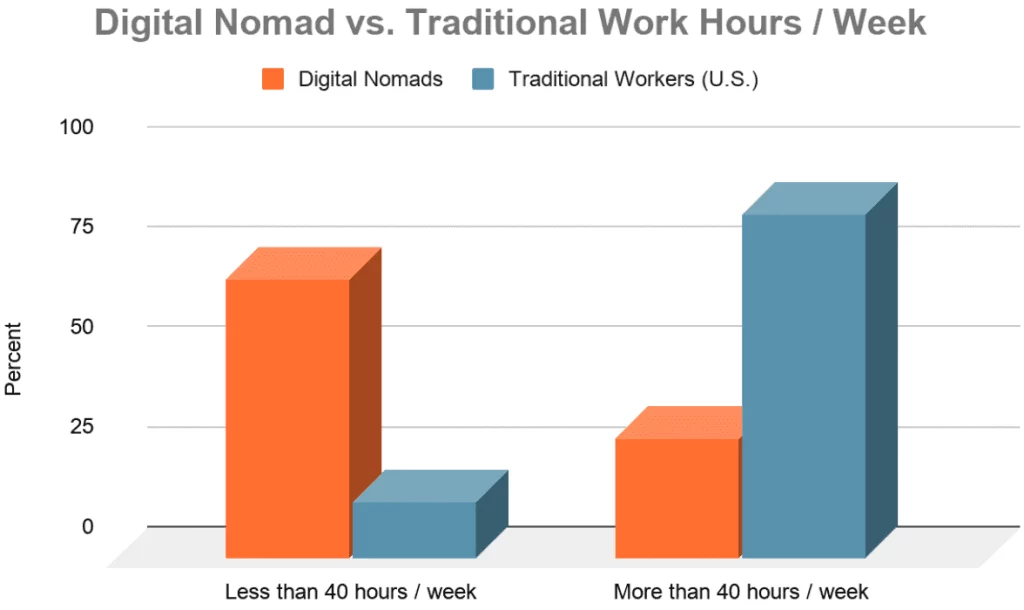The Digital Nomad lifestyle has emerged as a captivating phenomenon, where individuals embrace remote work and travel the world simultaneously. In recent years, this trend has experienced an extraordinary surge, with an increasing number of people choosing to lead a nomadic life. This blog post delves into the rapid rise of Digital Nomads, highlighting the reasons behind its popularity and the allure of living and working on the move.
Fact’s About Nomad Lifestyle
The advent of technology, coupled with shifting work paradigms, has paved the way for the rise of Digital Nomads. Enabled by the internet and various collaboration tools, people have found innovative ways to work remotely, unshackling themselves from traditional office environments.
Here’s some fact about Digital Nomad :
- The number of digital nomads from the U.S. has nearly quadrupled in the past four years, reaching a staggering 16.9 million.
- The total global count of digital nomads has skyrocketed to over 35 million, with 52% originating from the United States.
- Among digital nomads, 47% fall into the age group of 30s.
- American digital nomads comprise 76% White, 18% African-American, 8% Hispanic, 4% Asian, and 3% from other ethnic backgrounds.
- The pandemic-induced surge in remote work has caused a shift, with 66% of digital nomads being traditional remote employees, and 34% being independent workers.
- An encouraging 49% of digital nomads are earning the same or even higher salaries compared to their previous office jobs.
- With a lower cost of living, 45% of American digital nomads earn over $75,000 per year.
- The digital nomad lifestyle appeals to 71% of practitioners, who plan to continue it for at least the next 2 to 3 years.
- Only 24% of location-independent remote workers combine work and travel simultaneously.
- Most digital nomads prefer a slower pace of travel, with only 17% visiting more than 5 countries per year.
- Reliable wifi remains a top challenge for over half of digital nomads, with 52% rating it as a concern.
- A manageable 30% of digital nomads report working over 40 hours per week.
- The number of van lifers, a subset of digital nomads, has reached 3.1 million in 2022, constituting 18% of American digital nomads.
Who Are Digital Nomads?
Digital Nomads are modern-day travelers who embrace a unique lifestyle of combining work and exploration while traversing the globe. With their trusty digital nomad laptop and a mobile office setup, they rely on travel-friendly mobile hotspots and open-source internet available at co-working spaces, coffee shops, or shared workspaces.
While some digital nomads prefer independent journeys, others opt for popular digital nomad programs, which offer the opportunity to travel in organized groups. Despite their diverse backgrounds and preferences, all digital nomads share a common thread – a deep passion for travel, adventure, and, above all, freedom.
This growing community of individuals has transformed the way people perceive work and travel, as they challenge traditional office-based routines and seek a life of exploration and flexibility. Armed with technology and a thirst for adventure, digital nomads epitomize the essence of modern-day nomadism in a digitally connected world.
There are an estimated 35 million digital nomads worldwide, and the number of digital nomads from the U.S. has grown to more than 16.9 million. [1]

In 2019, the count of American digital nomads was 7.3 million. However, between 2019 and 2020, this number witnessed a remarkable surge of 49%, reaching an astounding 10.9 million, largely influenced by the impact of COVID-19. As the trend continued, by the end of 2022, the population of digital nomads in the United States further skyrocketed to an impressive 16.9 million.
Why this is happended?
The convergence of enhanced flexibility, higher salary expectations, freedom, and the capability to work from any corner of the globe.
The growth of digital nomads is merely in its early stages, and experts predict that by 2035, the global count of digital nomads is expected to reach a staggering one billion. [2]
One of the top challenges of digital nomad jobs is finding reliable wifi and internet connection.
Finding reliable wifi is one of the primary challenges faced by digital nomads. More than half of digital nomads (52%) consider it a top hurdle in their nomadic lifestyle. Slow mobile hotspots, unreliable internet cafes, unpredictable hotel wifi, and security concerns with shared internet are the main culprits behind this struggle.

However, wifi is not the sole obstacle. About 29% of digital nomad lifestyle report difficulties when working with colleagues in different time zones, and 20% find communication to be tricky. Previous surveys also showed that 30% found it challenging to navigate time zone differences. [1] [3]
Besides work-related issues, personal safety concerns (34%), missing family and friends (32%), and feelings of loneliness (26%) are common struggles faced by nomads. These challenges often lead many to abandon the digital nomad lifestyle. Nevertheless, some ex-digital nomad who were interviewed express their intention to return to the nomadic way of life.
On a positive note, solutions to these problems are being actively pursued. For instance, if loneliness sets in, it’s now easier than ever to connect with digital nomad communities that have formed all over the world. Platforms like Nomad List also assist in researching safe and nomad-friendly destinations.
Moreover, coworking spaces are emerging even in remote locations, addressing the wifi issue and providing nomads with suitable work environments. As these solutions gain traction, the future looks promising for digital nomads, and more individuals are finding ways to overcome the challenges and embrace the freedom and adventure of the nomadic lifestyle.
Digital nomads are incredibly efficient when it comes to productivity.
Digital nomads, a distinct category of remote workers, possess the skill to condense their work into shorter timeframes, allowing them to accommodate their travel interests seamlessly into their schedules.
According to a survey, around 70% of digital nomads work for 40 hours or fewer per week. Surprisingly, less than one-third of nomads exceed the 40-hour threshold, indicating that a majority of them enjoy a more favorable work-life balance compared to conventional workers. [3]

This holds particularly true for frequent-traveling nomads who invest significant time in planning out the logistics – a task that can be considered a job in itself.
The more you embark on journeys, the more time you dedicate to organizing transportation, securing accommodation, researching cultural aspects, and adapting to the unique dynamics of each new destination.
Another factor contributing to the reduced work hours among digital nomads is their lower cost of living. For instance, the rent in San Francisco is nearly 500% higher compared to Bali. Consequently, nomads making such a move could potentially slash their working hours by 75% or more while maintaining similar earnings. [4].


